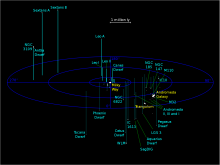Listen to today's episode of StarDate on the web the same day it airs in high-quality streaming audio without any extra ads or announcements. Choose a $8 one-month pass, or listen every day for a year for just $30.
You are here
Winter Milky Way
Our solar system resides in a giant spiral galaxy — the Milky Way. It’s a thin disk more than a hundred thousand light-years across. Bright, young stars outline spiral arms. The major arms extend from a thick bar of stars in the galaxy’s middle.
It took a long time for astronomers to figure all of this out. In fact, they’re still trying to complete the picture. They’re also still learning about our place in the Milky Way.
The problem is that we’re inside the disk. Giant clouds of dust absorb the light from distant stars, so it’s hard to create a roadmap. It’s like standing in the middle of a forest and trying to map all of its trees.
Fortunately, there are some ways to see through the trees. Radio waves and infrared light shine through the clouds. That allows astronomers to map giant clouds of gas throughout the galaxy, revealing its structure and our place in it.
They’ve discovered that we’re about 27,000 light-years from the center of the galaxy — about half way to the edge. We’re inside a short spiral arm, known as the Orion Arm or Local Arm. And it takes the Sun about 225 million years to complete one full turn around the galaxy — one galactic year.
To see the Milky Way, find a safe site far from city lights. Pick a moonless night, like tonight. At nightfall, the glowing band of the Milky Way arcs from almost due east, high across the north, to due west. It passes overhead around midnight.
Script by Damond Benningfield






